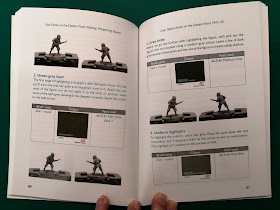The latest addition to the Wargames Terrain and Buildings series of books from Pen and Sword is WWI Trench Systems by Douglas Hardy. It is good to see that they are expanding the series with different authors (not that there is anything wrong with Tony Harwood's books). As the title suggests this book concentrates on trenches which means it is more aimed at terrain boards rather than scatter terrain.
Firstly, it is worth pointing out (as the book does in the introduction) that, although it is aimed at WWI trench systems, the techniques shown will work just as well for any period that uses trenches, whether it be late ACW or right through to sci-fi games.
The book is divided into several sections that cover using (and improving) commercially available trench terrain, scratch building trench systems, specific projects, and finally a great selection of reference photos of either original trenches or reconstructions at various museums across Europe.
Then we get into the guts of the book with building a trench table using commercially available trench systems. Douglas covers a selection of different commercially available systems, both foam-based and vacuum formed.
The book covers improving the bought pieces by adding details and also the painting process.
The final section of the book is an extensive collection of photographs of original trenches or reconstructions. This is something that I feel has been missing from the previous books in this series. This is a real boon for anyone wanting to build a trench system as it gives us an accurate picture of what the real thing looked like rather than just ideas from our own imagination or captured from movies etc.
The next part of the book looks at scratch building a trench system. This was the section that was of most interest to me as I feel it will offer the opportunity to produce the most realistic-looking table and it also gives me the freedom to design a system that fits my needs, rather than assembling a bought system. Now clearly there is going to be more work involved in creating your table from scratch rather than buying a pre-made system. However, as I am a professional model maker it is just the way I prefer to go.
The book covers everything from the layering up of foam sheets and cutting the trenches into them through adding planking, sandbags, barbed wire and other details. Then finishes off with the painting.
Next up we move on to "Projects" which covers adding specific terrain items to your trench table to add a little more interest (and possibly objectives for games). Again a very useful chapter that is well written. However, I did find it a little odd that Douglas chose to base one of the projects around a piece of commercially produced terrain that has been out of production for many years and is therefore going to be extremely difficult for readers to get a hold of.
The final section of the book is an extensive collection of photographs of original trenches or reconstructions. This is something that I feel has been missing from the previous books in this series. This is a real boon for anyone wanting to build a trench system as it gives us an accurate picture of what the real thing looked like rather than just ideas from our own imagination or captured from movies etc.
Overall I really enjoyed this book. I found an easy and quick read. It will be invaluable for any wargamer who wants to create a trench system for their gaming table and I highly recommend it.











